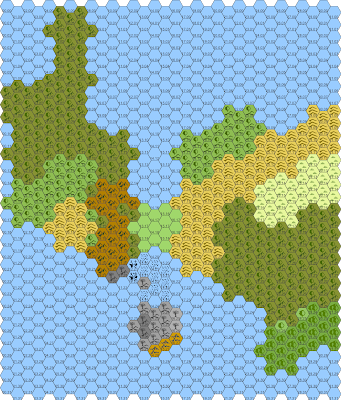The domain rules for Adventurer Conqueror King System are mostly contained in chapter 7: Campaigns. This chapter covers advanced magical research, accumulating divine power, building strongholds, and mercantile ventures. Basically, this chapter is about what high level characters can do. First up are options for high-level mages.
Mages can create many different kinds of minions: constructs, undead, cross-breeds. The general formula is 2000 GP per hit die plus 5000 GP for each additional special ability plus 5000 GP per plus on the magic research throw (and some one-time facility costs). There are some other minor differences between the required components, but the creation template for all minions is approximately the same. The limit here is fundamentally economic, as it seems like there is no other limit to the number of minions that can be created. Individual minion hit die total is restricted based on caster level. As a player, I’ve always loved having minions (that is probably why the necromancer is one of my favorite classes), so I think this is great.
It also helps answer the naturalistic question of where all those damn weird monsters came from. A mage did it. This has been the backstory to plenty of D&D locations in the past as well, but somehow encoding it in the rules like this makes it feel more internally consistent. Trivia regarding cross-breeds: the chaotic alignment is a dominant genetic trait. As in, if you crossbreed a lawful and chaotic monster, the result is chaotic. I wonder if this holds for PCs too? (Take away: be careful who you breed with.)
On to strongholds. In OD&D, everyone built castles, though guards and retainers varied by class. The list of possibilities given in ACKS are highly class dependent, and include, for example, border forts for the ranger-like explorer class, castles for fighters, sanctums for mages, and vaults for dwarves. It’s a nice list and we are treated to the standard info about how much gatehouses, towers, dungeon corridors, and walls cost. Personally, I would probably disassociate many of the strongholds with classes (or at least make some of them open to all classes). Not all thieves want to run a crime syndicate, for example. And if a mage wants to build a castle, become a king, and attract soldiers, why not? What better cover for the dark and arcane rituals that proceed deep beneath the keep? In any case, there is nothing wrong with the guidance given, and it is easy enough to overrule on a case by case basis.
I find the whole issue of demihuman and humanoid civilizations working analogously to human civilizations, but with only slightly different input parameters, highly problematic. Perhaps there is no other way to design the rules in a way to allow demihuman PCs. This was brought into focus for me by this sentence from page 127:
Elven fastnesses are settled by elven peasants.
There are elf farmers? Do elves do everything that humans do, but just take longer and do it in a different language? To me, these elves and dwarves are really more like another nation of humans, but readers of this blog will know that this is more of a longterm personal issue of my own, and so it probably won’t come up for most players of ACKS (who I’m guessing are probably fine with standard fantasy elf nations and dwarf nations). I mention this only because in ACKS these assumptions about the nature of demihumans are baked into the domain rules.
It is even suggested that PC mages build a dungeon and stock it with monsters. These rules are pure win and a triumph of Gygaxian Naturalism. Apparently, many magical research procedures require materials such as 4 basilisk horns. Yuck, right? Way too much like an MMORPG grind. But wait, there’s more. Check this, on page 141:
Many mages devote their later careers to magical research. This vocation demands a constant supply of rare components, generally monster parts, such as the fangs of 20 hellhounds or skulls of 50 ogres. Rather than squander their time hunting beasts for these components, many mages build dungeons within their domain with the aim of luring monsters to lair within. There they can be harvested at the mage’s leisure.
The text goes on to explain how more powerful monsters will displace weaker monsters in the lower levels, creating a natural sorting effect such that monsters residing deeper will be more dangerous. Sound familiar? I could see this turn into an odd role-reversal game, as the referee roles up parties of low-level adventurers to delve the PC’s dungeon. Man, that sounds like fun. In fact, reading further, that’s almost exactly what they suggest (page 142):
Some results on the Wandering Monster table will indicate that NPC men, dwarves, or elves have arrived. These results mean that adventuring parties have come to clear the dungeon! Such encounters are best resolved by having the player whose mage owns the dungeon run a one-off session with the rest of the group playing as the wandering adventurers. The dungeon-owning mage may, of course, intervene personally when his dungeon is invaded.
Thus, it all ends up tying together, almost seamlessly. Endgame PCs are the nemeses of starting PCs. It’s almost too clever. In fact, though this justifies pretty much every classic D&D dungeon delve, it does do away with one of the central old school dungeon design principles, which is that dungeons were originally built for something else and only later populated by monsters. It seems to me like a dungeon actually designed for housing monsters would have dramatically different architectural principles and dungeon dressing. Maybe I’m just being too picky though.
There are other things you can do at the domain level. If you are running a thief, assassin, or elven nightblade, the default stronghold is a hideout and your followers end up being a criminal gang. You can earn passive income from your underlings, as they provide all kinds of shady services (ACKS calls them hijinks). Some examples are thievery, information gathering, and assassination. There are tables provided so you can (mostly) just roll for this rather than roleplaying it out. Once you accumulate a certain number of underlings, it would really be impossible to roleplay it all out anyways. There is also extensive information about penalties and costs for underlings that get caught.
The system for resolving trade looks really complicated. Here are a list of some of the numbers and modifiers you may need to take into account to resolve a trade expedition: market price, base price, demand modifier, monopoly bonus, moorage and stabling fees, market class, market toll, modifiers for economic and political factors, labor fee for loading and unloading, customs duty, extra earnings for taking on passengers, and extra earnings for taking other shipping contracts. Whew! That’s a lot of moving parts. Maybe it’s easier in practice than it looks on paper, but if I had a character that was doing this regularly, I would probably write a program or build a spreadsheet to automate it.
I should mention the tremendous number of prices that ACKS provides. It doesn’t matter to me if these numbers are exactly realistic so much as that they seem to make sense within the context of the other prices in the game. The price of land per acre is given. And many more such things. This is very useful, even if you don’t really care about all of the sums tallying. All these numbers really show the scale of the protagonists in ACKS. A single stronghold securing a portion of wilderness must cost at least 30,000 GP per six mile hex. The land value of 16 such hexes is given at over 1 million GP.
One nice side effect is that hexes can only support so many people, so if you have a healthy and growing domain there will be expansion pressure. You need to send out the legionaries to secure more land. Which in turn requires increased defense investment to maintain the conquered land. Another option is to build a city, which can support a higher density of population.
It looks like this will lead to a nice little sim city minigame. How many peasants do I have per hex? What do I have to spend to maintain the infrastructure? What do I earn in taxes? Has my population grown this month? That is determined by what looks like an exploding random walk to me, but I haven’t investigated the math in detail. I’m not sure if this is for everyone, but it certainly captures the actuarial spirit of AD&D.
Finally, characters earn standard XP from many of these domain activities, such as building strongholds, earning domain income (if above a leve-based threshold), trading (also if above a level-based threshold), and expensive magical research. So you could theoretically sim city your character up a few levels, though of course any decent ref will present continuous challenges.
I would like to close with a quote from Frank Mentzer about high-level characters from the Companion set (Player’s Companion: Book One page 2):
Characters are more independent. When the characters started their careers, they needed each other just to survive. But now a few trolls present nothing more than exercise, rather than deadly danger. Now the characters aren’t as dependent on each other; each can survive and prosper as an individual. The persons with whom a character adventures are now more important as friends, than as as each others’ bodyguards.
I think this is an important point regarding how the game changes from explicitly team-oriented at low levels to more self-reliant by the time characters start building strongholds. I have not read much discussion of this change in ACKS so far. I imagine many referees will by default favor an “Avengers Assemble!” style of play regarding domain level characters. By that I mean that between adventures, PCs will probably separate and go their own ways but then reunite to investigate the mysterious floating citadel (or whatever). Given that so many of the new rules that ACKS provides (over and above classic B/X) are focused on domain level play, it would be nice to see more discussion about adventure design and how it should change to accomodate powerful PCs. I haven’t read chapter 10: Secrets (the referee chapter) fully yet, so maybe there is more guidance there.
My next post on ACKS will focus on the setting creation guidelines.







